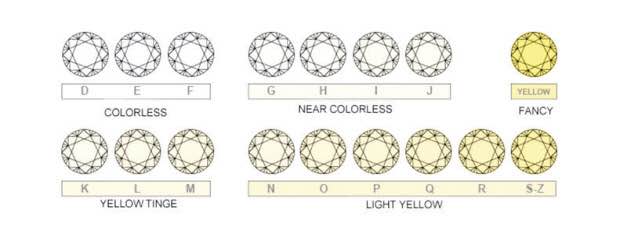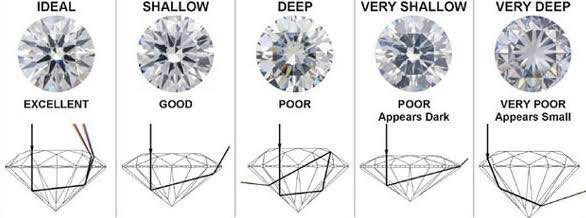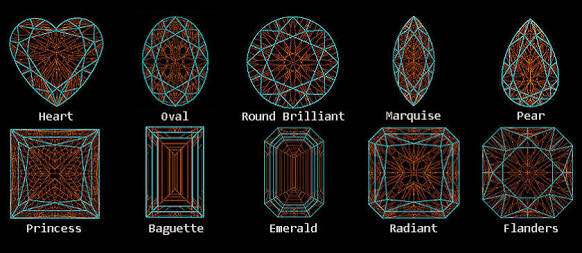Cart
0
Product
Products
(empty)
No products
To be determined
Shipping
0,00 €
Tax
0,00 €
Total
Prices are tax included
Product successfully added to your shopping cart
Quantity
Total
There are 0 items in your cart.
There is 1 item in your cart.
Total products
(tax incl.)
Total shipping (tax incl.)
To be determined
Tax
0,00 €
Total
(tax incl.)
THE FOUR C: color, clarity, cut, carat weight
They have put the four main, and different characteristics that determine the rarity and value of a diamond.
Some diamonds are rarer than others and it is the best combination of the 4Cs which the most valuable.

COLOUR
The diamond is the only gem in which the absence of color determines its value. Diamonds are available in a variety of white tones. The evaluation of the color of a diamond for the purpose of classification is obtained by measuring the degree to the total lack of color. Those that are closest to the absence of color are very rare and are classified D, E, F and G while most of them are white / slightly browned. The letter D refers to stones perfectly colorless, the most rare and expensive.
In this scale using the letters of the alphabet starting with the letter D (colorless) until you reach the letter Z, as the saturation increases. Diamonds where the color intensity is beyond Z, are classified as "Fancy Color".
The quality of color is determined by comparing the gemologist Diamond to be analyzed with a variety of stones of reference called "Master Stones"
In nature there, as well as yellow, pink diamonds, blue, orange, brown, green and even red (considered among the rarest ever).

CLARITY
Each diamond possesses its identity due to the presence of small traces of carbon or small crystals of different nature were imprisoned during the process of crystallization. These are called inclusions and are the structural inhomogeneities that are considered "nature's fingerprints". Their number, color, size and position determine the degree of purity of the diamond.
The purity is evaluated according to a scale on which there is based to describe the level of "imperfections" or "inclusions".
The purity levels include precisely:
- IF = No internal listening visible under 10x magnification to a trained eye.
- VVS-1 = Usually it is a single tiny inclusion visible under 10x magnification only by a trained eye.
- VVS-2 = Very small inclusions visible under 10x magnification only by a trained eye.
- VS-1 = Very small inclusions visible under 10x magnification.
- VS-2 = Several very small inclusions visible under 10x magnification.
- SI-1 = Small inclusions visible under 10x magnification.
- SI-2 = Several small inclusions visible under 10x magnification.
- SI-3 = inclusions visible to the naked eye only by a trained observer.
- I-1 = inclusions visible to the naked eye.
- I-2 = Many inclusions clearly visible to the naked eye which decrease the brilliance.
- I-3 = Many inclusions clearly visible to the naked eye which decrease the brilliance and compromise the structure of the diamond, making it more fragile.

CUT
The cut is a process of fundamental importance for the visual rendering of a diamond. The brilliant cut classic includes 58 facets of which 33 are on the top (or crown) and 25 on the lower (or pavilion). The optimum brilliance is achieved when the crown is a third of the total height of the diamond. This is certainly the most important of 4C, as the higher is the quality of the cut, the better the combination of brilliance and fire of the stone. The proportions of a stone are the most important parameter for evaluating the sparkle of a diamond.
The cut is evaluated by a quality scale that includes:
- Cutting excellent (EX) or ideal (IDEAL CUT): Round diamonds perfectly proportioned (with depth% and table% such as to create the best compromise between fire and brilliance). These diamonds are almost always the highest levels of brightness and symmetry underlining the extreme care put into their work. The skills and expertise used to perform this cut allow the creation of a diamond top beauty. Diamonds "ideal cut" are usually much more expensive than otherwise cut. This is due to three main factors: 1) require more time and a greater ability to cut a diamond with such precision, 2) stones are in great demand, and perhaps most importantly, 3) have to sacrifice a good part of the diamond original raw to get the ideal proportions.
- Cut very good (VG): Diamonds cut according to proportions that exactly match the requirements of depth% and table%. These unusual proportions maximize fire and brilliance of the diamond.
- Cutting good (G): Diamonds cut according to proportions acceptable but not ideal. These stones generally have a good level of brilliance and fire, and jewelry are of excellent quality.
- Cutting medium (M): Diamonds cut according to proportions that deviate from the ideal. They were cut in order to recover more possible weight from the rough stone at the expense of fire and brilliance. Although they are less expensive diamond cut according to a cut as excellent or good, they do not have the brilliance and sparkle that you would expect from a diamond.
- Cutting poor (P): Diamonds cut according to proportions that make them appear relatively lackluster. We do not recommend these stones.
CARAT WEIGHT
The weight of diamonds, like that of other gems, is expressed in carats. A CARAT is equal to 0.2 grams, so it takes 5 CARAT to form one gram. The term derives from the greek CARAT keration and indicated the carob seed, the weight of which is very homogeneous. In the diamond industry the weight of gemstones is measured to the thousandth of a carat and then rounded to hundreds, commercially called "point".
The price of the diamond, which is expressed per carat, never increases in mathematically in relation to its weight. So a diamond weighing two carats does not cost twice as a one carat stone of the same quality, but a lot more.


